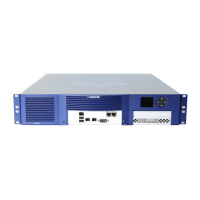Specifying Appliance Settings
For the Infoblox 2200 Series Platforms 29
A static IP address is set and auto-provisioning is automatically disabled for the appliance after it joins the
Grid. If the Grid member fails to join the Grid, then the remote console is enabled for the appliance and you
can join the appliance to the Grid through the remote console. You can login to the remote console using the
user name admin, and the Grid shared secret as the password.
Note: When auto-provisioning is disabled for an appliance and the network address is not preserved,
auto-provisioning will be re-enabled and a DHCP lease request is sent to the DHCP server if you reset the appliance
using the CLI command reset all or reset the database using the CLI command reset database. However,
if the static IP address for an appliance is set and network settings are preserved, auto-provisioning will be
re-enabled for the appliance but the lease address will not be requested if you reset the database using the CLI
command reset database.
Specifying Appliance Settings
After the initial HTTPS connection to the Infoblox appliance, the Setup Wizard guides you through the basic
deployment of the appliance on the network.
You can deploy an appliance individually or in an HA (high availability) pair, for hardware redundancy. A single
appliance or an HA pair without a Grid license runs independently from a Grid. A Grid is a group of two or more
Infoblox appliances that share sections of a common, distributed, built-in database and which you configure and
monitor through a single, secure point of access—the Grid master. To set up a Grid, you must configure a single or
HA Grid master and at least one Grid member, which can also be a single appliance or an HA pair.
The following instructions Guide you through the wizard and include worksheets where you can note your appliance
and network settings. After you complete the wizard, you can set additional operational parameters and configure
the appliance to provide services, such as DNS and DHCP. For detailed instructions on configuring network services
on the appliance, refer to the NIOS Administrator Guide.
1. Open an Internet browser window and enter https://
<IP address or hostname of your appliance>
.
2. Accept the certificate when prompted.
A certificate warning appears during the login process. This is normal because the appliance generates a
self-signed certificate when it first starts, and your browser does not have a trusted CA certificate or a cached
appliance server certificate (saved from an earlier connection) to authenticate the appliance certificate. Also,
the hostname in the default certificate is www.infoblox.com, which is unlikely to match the hostname of your
appliance. Messages appear warning that the certificate is not from a trusted certifying authority and that the
hostname on the certificate is either invalid or does not match the name of the site that sent the certificate.
Either accept the certificate just for this session or save it to the certificate store of your browser.
Note: To eliminate the certificate warning, generate a new self-signed certificate or import a third-party
certificate with a common name that matches the FQDN (fully-qualified domain name) of the appliance. The
process is straightforward. For information about certificates, refer to the NIOS Administrator Guide.
3. Log in using the default user name and password admin and infoblox.

